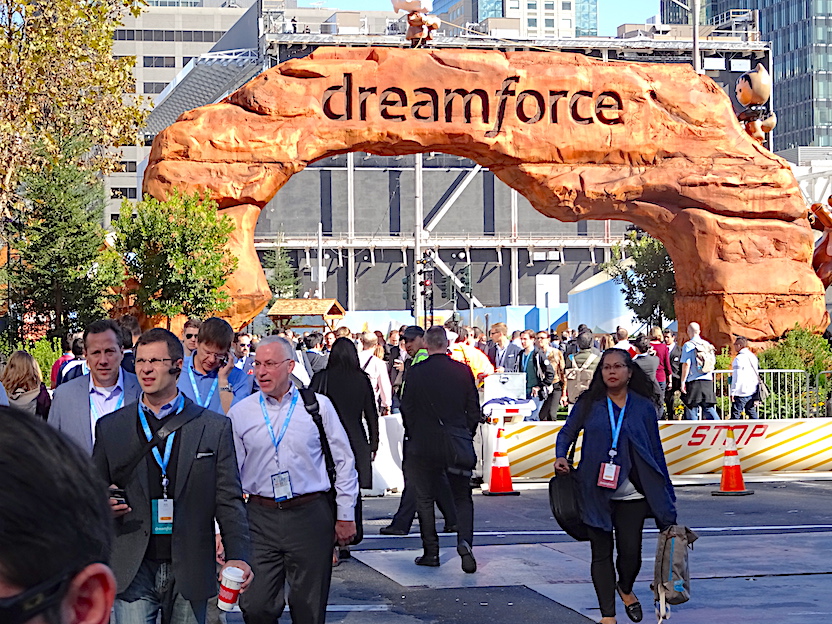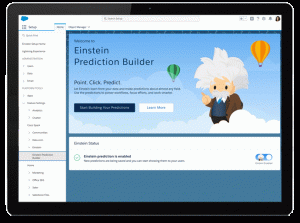 CLOUD
CLOUD
 CLOUD
CLOUD
 CLOUD
CLOUD
Customer relationship management giant Salesforce.com Inc. made a big splash at last year’s Dreamforce conference, introducing its artificial-intelligence platform Einstein as a way to bring the benefits of AI to the business masses. This year, it’s looking to inject those AI smarts into all its services to make them more personalized and easy to use.
That will be apparent in a raft of announcements at its huge annual conference, which will draw some 170,000 customers, software developers and partners to San Francisco this week. What’s striking about the announcements to be made today is that there’s no big new cloud getting added to the Marketing Cloud, Sales Cloud, Service Cloud and others that make up the company’s platform.
Instead, the San Francisco-based company is looking to make its existing services more customizable, pointedly adding the word “my” to several of them in announcements today. Salesforce.com President and Chief Product Officer Alex Dayon said in a briefing for reporters last week that a key theme will be that we’re heading into a “fourth Industrial Revolution.” Technologies such as AI (personified in its Einstein mascot, above) and the “internet of things” will need to be much more accessible to the broader community of business people, not just a cadre of data scientists.
“There’s a lot of anxiety about the new world we’re stepping into,” Dayon said. “Our mission as a software vendor is to give access (to AI) to this wider community. It’s a big leap for us: AI as a platform as opposed to AI in our own business.”
Salesforce has been on a roll for some time. In its latest quarter, it beat earnings estimates, surpassing a $10 billion annual revenue run rate faster than any enterprise software provider in history, and raised its forecast for the current quarter.
Yet the company continues to face more competition from the likes of Oracle Corp., Adobe Systems Inc. and IBM Corp. in marketing and advertising, Amazon.com Inc. in cloud computing applications and Google LLC, Microsoft Corp. and Facebook Inc. in AI-driven services. Indeed, close to two-thirds of its total operating expenses came from sales and marketing, an indication of the lengths to which it has to spend to maintain its growth.
Becoming more of a platform for services, not all of which it builds itself, may be key to competing in this world of internet giants, some of which have been suggested as potential acquirers of Salesforce. And making that platform more easily customized, as it’s aiming to do with the new “my” services, will be critical to setting itself apart and making its services even stickier.
To help make that happen, Salesforce is announcing several more personalized Salesforce platform services. They include:
* MyTrailhead, which extends its Trailhead three-year-old learning platform to allow businesses to customize the service with their own content and branding. “In the Fourth Industrial Revolution, skilling up has never been more important,” said Sarah Franklin, senior vice president of developer relations and general manager of Trailhead.
Although an education and training program doesn’t sound like a game-changer, Salesforce has made Trailhead a central piece of its growth goals. “If they want to get to $20 billion or $50 billion, they have to make adoption easier,” Denis Pombriant, founder and managing principal at the analyst firm Beagle Research Group, told SiliconANGLE.
 * MyEinstein, a version of the AI technology that Salesforce said will enable a wider range of developers and administrators to build custom AI-powered apps with “clicks, not code.”
* MyEinstein, a version of the AI technology that Salesforce said will enable a wider range of developers and administrators to build custom AI-powered apps with “clicks, not code.”
The offering includes two new services: Prediction Builder, which helps customers create custom AI models to predict outcomes for any field or object in Salesforce, and Einstein Bots, which allows for quick building and training of custom bots for customer service. “We’re abstracting out that data science, because there aren’t enough data scientists in the world,” said John Ball, senior vice president of product and general manager of Einstein.
* MySalesforce, a set of point-and-click, so-called low-code tools to create branded mobile apps and publish them to Apple Inc.’s App Store and Google Play. “We have lots of companies with pockets of underserved potential mobile users,” said Mike Rosenbaum, executive vice president of CRM applications.
* MyLightning, a framework for application development and customized user experiences.
* MyIoT, the next generation of Salesforce IoT that promises to allow any users to leverage IoT data so they can combine connected device, sensor and application data with customer data to create new experiences. An auto dealer, for instance, could create a workflow that schedules service calls based on when vehicles likely have passed a certain mileage level.
Finally, Salesforce announced the Quip Collaboration Platform, which includes Quip Chief Executive Bret Taylor calls “documents with superpowers.” Live Apps, as the superpowers are formally called, are applications such as calendars, polls and comments that can be embedded into Quip along with real-time data, allowing teams to pull together documents, spreadsheets, team communications and live application into one centralized “canvas.” “We’re transforming documents to become applications,” said Taylor.
Already, some outside partners such as Atlassian Corp. plc and Facebook with its Workplace service and DocuSign Inc. have developed Live Apps. “The idea of a collaboration platform that’s isolated is an oxymoron,” said Taylor, a former Google manager and Facebook chief technology officer.
The lack of an entirely new cloud service may suggest that Salesforce isn’t sure where to cast its net next — though it clearly has big ambitions, as it revealed it had made a run at LinkedIn before Microsoft swooped in. But the focus on bolstering existing services rather than introducing entirely new ones doesn’t surprise some company observers.
“At some point, the West was settled,” said Pombriant. “We’re getting to the point where the technology is getting pretty well built out.”
Making cloud services more personalized and easier to use is critical, and not just for Salesforce, he noted: “We need to get to utility computing.” With services such as Salesforce’s, and others ranging from Amazon Web Services Inc.’s and Microsoft Azure public clouds to Oracle’s recently introduced “autonomous database” service, he said, “it’s now around the corner.”
Salesforce customarily saves some news for Chief Executive Marc Benioff’s keynote, which will be at 3 p.m. PST Monday, and this year is no exception, as the company has scheduled an earlier press conference for more news to be announced during the keynote. Given the platform push, it may involve bringing all of Salesforce’s separate clouds more together, something Pombriant said it is an ongoing project at the company.
It wouldn’t be a Salesforce event without some celebrity appearances, either. Actor Ashton Kutcher will be onstage Monday, former first lady Michelle Obama on Tuesday and musician Will.i.am and philanthropist Laurene Powell Jobs on Wednesday. A benefit concert for, not surprisingly, UCSF Benioff Children’s Hospitals in San Francisco and Oakland will feature Alicia Keyes and Lenny Kravitz.
Support our open free content by sharing and engaging with our content and community.
Where Technology Leaders Connect, Share Intelligence & Create Opportunities
SiliconANGLE Media is a recognized leader in digital media innovation serving innovative audiences and brands, bringing together cutting-edge technology, influential content, strategic insights and real-time audience engagement. As the parent company of SiliconANGLE, theCUBE Network, theCUBE Research, CUBE365, theCUBE AI and theCUBE SuperStudios — such as those established in Silicon Valley and the New York Stock Exchange (NYSE) — SiliconANGLE Media operates at the intersection of media, technology, and AI. .
Founded by tech visionaries John Furrier and Dave Vellante, SiliconANGLE Media has built a powerful ecosystem of industry-leading digital media brands, with a reach of 15+ million elite tech professionals. The company’s new, proprietary theCUBE AI Video cloud is breaking ground in audience interaction, leveraging theCUBEai.com neural network to help technology companies make data-driven decisions and stay at the forefront of industry conversations.